Table of contents
Rhubarb ( Rheum rhabarbarum ) or vegetable rhubarb should be eaten cooked. If eaten raw or in large quantities, it can be dangerous.
Use in the kitchen
What does rhubarb taste like? Rhubarb tastes refreshing and piquantly sour. The fruit acids, especially malic acid, citric acid and oxalic acid, are important for the taste of rhubarb. The color of the leaf stalk indicates the quality, and the preferred order is red, pink and green. 7 varieties with red stem pulp have fewer fruit acids than those with green. Red rhubarb has a milder taste and a lower oxalic acid content. Green stems have a higher oxalic acid content and therefore taste more intense. 2, 18 Depending on the variety and degree of ripeness, the stems can be consumed unpeeled or peeled.
Although many valuable ingredients are usually lost when vegetables are cooked, the oxalic acid in raw rhubarb reduces the bioavailability of important minerals such as calcium and magnesium . 3, 20 This can be dangerous under certain circumstances, especially for children or people with gallbladder or kidney diseases. 3 You should not use the leaves because of the high oxalic acid content.
Because of the way it is prepared and its taste, low-calorie rhubarb is generally considered a fruit, although it is actually a vegetable. The most well-known dishes made from rhubarb are jams and compotes (both of which are also made on an industrial scale), as well as cakes and muffins. Rhubarb is also pressed into juice and processed into must or ice cream. Spicy chutneys are a tasty change. Rhubarb is rarely eaten as a vegetable: the flower buds are cooked like broccoli or cauliflower .
The oxalic acid can be reduced either by choosing certain types of rhubarb (e.g. "Holsteiner Edelblut" with red stalks) or neutralized by using certain spices and ingredients. These include lemon juice, angelica stalks, nutmeg, cloves, cinnamon and bay leaves . These spices also go well with the aroma of rhubarb. Traditional English rhubarb jams, on the other hand, are refined with ginger, oranges and arnica. If you use thicker old stalks as well as young ones, it is an advantage to peel off the skin. This is because it contains the most oxalic acid. 3,17
The oxalic acid contained in rhubarb reacts with aluminum and other metals. Therefore, rhubarb should not be cooked in aluminum pots or wrapped in aluminum foil. Use (fireproof) glass and porcelain dishes for cooking and acid-resistant plastics for storing. 3 Please throw away the cooking water and do not reuse it or drink it.
Vegan recipe for rhubarb cake
Ingredients: 180 g vegetable margarine, 270 g whole wheat flour, 600 g organic rhubarb, 220 ml soy milk, 150 g raw cane sugar, 3 tsp baking powder, 1 pinch of salt, pulp of a vanilla pod .
Preparation: To prepare, wash, peel and chop the fresh rhubarb. Beat the soft margarine with sugar, salt and vanilla sugar until fluffy. Then mix the flour with the baking powder and add to the margarine-sugar mixture together with the soy milk. Stir the entire mixture into a smooth dough and put half of it into a greased springform pan. Mix the second half with the chopped organic rhubarb and spread evenly in the springform pan. Bake the cake in a preheated oven at 170 °C top and bottom heat or 155 °C fan oven for around 60 minutes. Only remove from the pan and cut into pieces once it has cooled completely.
Tea preparation
To prepare rhubarb tea, use the seeds or the powder. To treat constipation, use 3-5 g of the powder or seeds in 1 dl/100 ml of hot water. For diarrhea, use 2 g in half a liter of hot water. In both cases, let it steep for about 15 minutes. Strain the infusion and take it in small sips throughout the day. 3
Vegan recipes with rhubarb can be found under the note: " Recipes that have the most of this ingredient ".
| Not only vegans or vegetarians should read this: Vegans often eat unhealthily. Avoidable nutritional errors . |
Purchasing - Storage
The edible rhubarb stalks are sold without leaves. You can find the vegetable in practically every supermarket and on the shelves of all major retailers such as Coop, Migros, Denner, Volg, Spar, Aldi, Lidl, Rewe, Edeka, Billa, Hofer etc. When choosing, make sure it is organically grown. Buy rhubarb directly from the weekly market, from the farmer, in the organic supermarket (such as Denn's Biomarkt, Alnatura ) or your trusted organic store. Rhubarb is in season from April to June .
Even if it is organic, you should not eat the leaves of the rhubarb. Everything green on the plant is considered poisonous due to its oxalic acid content. The oxalic acid in the stems is considered harmless if the harvest was made before mid to late June at the latest, because only after that does the oxalic acid content in the plant rise above a worrying level. 17
The availability of rhubarb varies depending on the size of the store, catchment area, etc. Our recorded food prices for the DA-CH countries can be found above under the ingredient image - and by clicking on them you can see their development at different suppliers.
Storage tips
Rhubarb is best processed immediately after purchase. If you want to keep the stalks fresh for a few days, wrap them in a damp cloth and store them in the refrigerator. 11
Can you freeze rhubarb? Rhubarb can also be frozen raw. When frozen, it will last for about a year. 11
Ingredients - Nutritional values - Calories
Rhubarb has a very low calorie content (21 kcal/100g). 4.5% of this is carbohydrates, of which about 1.1% is sugar and 1.8%is fiber . Proteins and fats are hardly present in this vegetable, but the water content is about 94%. 1
At 29 µg/100g, the vitamin K content is comparable to that of raw celery or alfalfa . Lower values are found in turnip greens (25 µg/100g), sauerkraut (13 µg/100g) and peas (25 µg/100g). Kiwi, celeriac and asparagus (all approx. 40 µg/100g) contain more vitamin K, while significantly more can be found in broccoli (approx. 100 µg/100g), spinach (approx. 483 µg/100g) and kale (approx. 705 µg/100g). 1 This fat-soluble vitamin is important for hemostasis (blood clotting) and bone health. 22 A natural and balanced vegan diet more than adequately covers the need for vitamin K.
Potassium is an essential element that is found in many foods. In terms of potassium content, rhubarb, with 288 mg/100g, is on a par with sauerkraut or similar to corn kernels . Dried herbs have a lot of potassium ( dried parsley : 2,683 mg/100g), but lamb's lettuce (459 mg/100g) and bananas (358 mg/100g) also have significant amounts. 1
Calcium is contained in 86 mg/100g. This corresponds to 11% of the daily requirement. Macadamia nuts have similar values (85 mg/100g). Calcium is contained in smaller amounts in grapes (10 mg/100g) and raisins (50 mg/100g). Dried spices such as oregano (1,597 mg) or rosemary (1,280 mg) have higher amounts. 1
You can find all the ingredients of rhubarb, how much it covers your daily needs and comparative values with other ingredients in our nutrient tables. In the article Nutrients comprehensively explained you will get a detailed insight into the topic.
Health effects
Is rhubarb healthy? Despite its oxalic acid content, rhubarb is healthy when cooked, preferably peeled and consumed in moderation. The plant is a good source of bioactive compounds, fiber, minerals and vitamin K. However, the oxalic acid in rhubarb combines with certain minerals to form insoluble complexes. 20 As a result, the body excretes these minerals instead of absorbing them (more on this below under Dangers - Intolerances - Side effects). 3
Rhubarb has a blood-purifying and intestinal-regulating effect, which is why it is recommended for detoxification treatments. 3 Emodin and other anthraquinones contained in rhubarb extracts have a positive effect on the gastrointestinal tract. They have been shown to increase blood flow to the stomach lining, increase the excretion of bacteria and toxins, and counteract intestinal permeability. 31,32,33
As a source of fiber, rhubarb has a potential lipid-lowering effect by inhibiting squalene epoxidase. 6 In men with high cholesterol, eating rhubarb stalks may lower LDL cholesterol while maintaining HDL cholesterol levels. 20
The vegetable is also said to have a positive effect on liver inflammation and anti-cancer properties. 20 The emodin and hydroxyanthraquinones contained in rhubarb may play a role in apoptosis (cell death) and have an anti-tumor effect. 33
Secondary plant substances
Many of the health effects of rhubarb can be attributed to the secondary plant substances it contains. Our article on secondary plant substances provides an overview of the classification of substance groups, their occurrence in foods and possible effects on humans. Rhubarb contains the following secondary plant substances, among others: 7, 20
- Polyphenols : flavonoids (flavanols, anthocyanins), tannins, glycosides
- Isoprenoids: triterpenes and triterpenoids (saponins)
- Other nitrogen-containing compounds: cyanogenic glycosides
However, it should be noted that the composition of secondary plant substances in rhubarb can vary depending on external factors such as temperature, light, fertilization and degree of ripeness. Therefore, quantities are only of limited use and should only be understood roughly.
Dangers - Intolerances - Side effects
How dangerous is oxalic acid? The oxalic acid in rhubarb binds to calcium and magnesium . Our body excretes the oxalic acid through the kidneys. If crystals form from the body's own calcium and oxalic acid, kidney or bladder stones can develop. 3,2,20 People with kidney and gallbladder disease and children (with an increased need for calcium) should therefore be careful. 3 It is possible to counteract the effects of oxalic acid by eating calcium - rich ingredients. 20
Too much raw rhubarb can lead to stomach pain and symptoms of poisoning such as cramps and circulatory problems. However, the lethal oral dose of oxalic acid is 15 to 30 g (600 mg per kg body weight). Smaller amounts can still cause nausea and vomiting. 8,21 The petiole and stem contain an average of 275 to 1336 mg and 460 mg of oxalic acid per 100 grams of fresh weight, respectively. 3, 20 The leaves contain around 500 mg/100g. 8
Oxalic acid is found in large quantities in rhubarb and other knotweed plants (e.g. sorrel ). Star fruits are also rich in oxalic acid. Similar quantities are found in wood sorrel ( Oxalis ), chard, spinach, parsley, cocoa, chocolate and beetroot . 3,4,24 Many fungi also secrete oxalic acid. 25
How dangerous are anthraquinones? In nursing mothers, components of rhubarb pass into the milk and have a mild laxative effect on the infant. 3,16 The anthraquinones contained in rhubarb have uterine stimulating and genotoxic effects that can affect pregnancy and breastfeeding. 5
Risk of confusion(s)
One should not confuse wild rhubarb with the visually similar "wild rhubarb", i.e. butterbur (common butterbur, lat. Petasites hybridus) . Butterbur in its natural state contains pyrrolizidine alkaloids, which are carcinogenic and possibly toxic to the liver. 13
Use as a recognized medicinal plant
The edible variety of rhubarb is a 19th century hybridization of the species Rheum rhabarbarum . The roots of edible rhubarb are not used as a medicinal plant. 9 Medicinal rhubarb consists of the dried rhizome and root of Rheum officinale or Rheum palmatum (Chinese rhubarb) or of Rheum tanguticum . 10,17
The roots of this medicinal rhubarb contain anthraquinone glycosides and are a well-known laxative in Chinese medicine. It is a bitter, cooling herb that, depending on the dosage, promotes digestion, stimulates the uterus and has a laxative effect. However, the leaves are poisonous. 3,9,33
Folk medicine - natural medicine
Rhubarb has traditionally been used to treat constipation, jaundice and ulcers. 20 The use of rhubarb is particularly widespread in traditional Chinese medicine. 17
Ecological footprint - animal welfare
The ecological footprint of a food depends on various factors. The type of agricultural production (conventional vs. organic), seasonal, regional or domestic production or import by truck, ship or plane, different types of packaging and whether the goods are fresh or frozen all play a decisive role. 28
According to CarbonCloud, rhubarb has a CO 2 footprint of 0.37 kg CO 2 eq/kg (mainly production), which is relatively low. Rhubarb juice has a CO 2 footprint of 0.52 kg CO 2 eq/kg (including production, transport and processing). 19
For comparison, vegetables, one of the most climate-friendly foods, have a carbon footprint of around 0.1-0.5 kg CO 2 eq/kg depending on the cultivation method (and excluding the impact of transport). 29 The average carbon footprint of plant-based foods is around 0.66 kg CO 2 eq/kg, which represents only 10.7% of the carbon emissions of animal products (6.15 kg CO 2 eq/kg). 30 To keep your carbon footprint small, it is best to eliminate animal products from your diet.
Despite extensive research, we unfortunately do not have any concrete figures on the water footprint of rhubarb. However, the global average water consumption for vegetables is low at 322 l/kg. 27
For detailed explanations of various sustainability indicators (such as ecological footprint, CO2 footprint, water footprint), see our article: What does the ecological footprint mean?
Animal welfare - species protection
Rhubarb leaves can be poisonous and even fatal for animals such as goats and pigs. 8
Worldwide distribution - cultivation
The genus Rheum (rhubarb) has around 60 species and is widespread in Asia. 20, 26 Rhubarb originally comes from Central Asia. The edible rhubarb Rheum rhabarbarum is also called common rhubarb, vegetable rhubarb or curly rhubarb. It grows wild in Central Asia, from southern Siberia through Mongolia to the Chinese provinces. 26 Today, rhubarb is grown in all temperate zones of the world. In Europe, mainly in the Netherlands, England and Germany. Some tropical and subtropical countries now also cultivate rhubarb. 12 However, it is rarely organic.
Rhubarb is a cultivated plant of little economic importance. In commercial cultivation (field cultivation and greenhouse), there are a large number of rhubarb varieties that meet market requirements. The food industry in particular prefers larger leaf stalks than private consumers. Varieties with reduced oxalate content are also bred. Vigorous varieties enable less intensive use of land and resources. The flowers are removed manually as they have a negative impact on yield. 23
Found in the wild
In contrast to Asia, rhubarb is rarely found in the wild in Europe. 20,26
Growing in the garden
Rhubarb is an easy garden plant, is very productive and grows quickly. It flowers after 2 - 3 years and the flowers have a diameter of 3 - 5 mm. Rhubarb varieties are propagated by splitting the rhizome. It is best to plant rhubarb in late autumn or early in the year. 11,23 When harvesting, the strongest stems should be pulled out by hand. Cutting the rhubarb can lead to root rot. About half of the stems (with leaves) should be left so that the plant can regenerate for the next harvest period. 11 Flowering time is in April and May. 11
How does rhubarb grow? The leaf stalks have a diameter of 30-50 mm. The stems are rarely 300 to 500 mm long and grow upright or semi-upright to horizontal. The leaf stalks develop from a central point of the rhubarb plant. The color of the leaf stalk ranges from red to pink to green. 7
Where do I plant rhubarb? Rhubarb needs a partially shaded location and deep garden soil. It thrives near a compost heap. The varieties "Holsteiner Blut" and "Sutton" are recommended for the garden. 17,18 The perennial grows well in mixed culture with neighbours such as peas, beans, spinach ,lettuce and kohlrabi .
How long can you harvest rhubarb? The ideal harvest time is from mid-April to the end of June, so that the oxalic acid content is not too concentrated. From July onwards, the plant begins a necessary regeneration phase. 11
Further information
Rhubarb ( Rheum ) is a genus of plants in the knotweed family (Polygonaceae). The name rhubarb ( Rheum rhabarbarum ) is derived from the Latin word rhabarbarum (also reubarbarum) and probably refers to a type of Rheum cultivated on the Black Sea coast. Reu barbarum could therefore mean foreign Rheum . 7
Medicinal rhubarb ( Rheum officinale and Rheum palmatum ) thrives in Tibet and China, but is now also cultivated in Austria and southern Germany. 3 It is one of the most commonly used Chinese medicinal plants and has been a valuable commodity since ancient times. In the Middle Ages, the dried roots of this medicinal plant were exported from east to west along the Silk Road. 14,17 Transport from China took a long time and was accordingly expensive. It is therefore assumed that medicinal rhubarb was rarely found in Europe at that time. This did not change in the centuries that followed, because first a Chinese and then a Russian trade monopoly prevented free transport to the West until the 19th century. 15 From the 18th century onwards, the English in particular diligently cultivated medicinal rhubarb. 9,17
The deadline for the last harvest, June 24th (St. John's Day), goes back to a farmer's rule. This "lot day" is traditionally known for the latest date for the rhubarb harvest and the last asparagus harvest. This ensures that the plants have enough time to regenerate and gather enough strength for the next year. 3,11
Alternative names
In English, rhubarb is known as rhubarb.
In traditional Chinese medicine, rhubarb is called Rhei or Dahuang. 10
Other applications
The food industry uses the extract of medicinal rhubarb (without its bitter substances) as a food flavoring and as a tanning agent. 7
Bibliography - 33 Sources (Link to the evidence)
| 1. | USDA United States Department of Agriculture. |
| 2. | Georg Vogel HDH. Handbuch des speziellen Gemüsebaues. Stuttgart: Eugen Ulmer; 1996. |
| 3. | Vogel Al. Gesundheitsnachrichten. 1998;55(5). |
| 4. | Schroder T, Vanhanen L, Savage GP. Oxalate content in commercially produced cocoa and dark chocolate. Journal of Food Composition and Analysis. 2011;24(7):916–922. |
| 5. | Ernst E. Herbal medicinal products during pregnancy: are they safe? BJOG. 2002 Mar;109(3):227–335. |
| 6. | Abe I, Seki T et al. Galloyl esters from rhubarb are potent inhibitors of squalene epoxidase, a key enzyme in cholesterol biosynthesis. Planta Med. 2000 Dec;66(8):753–756. |
| 7. | Mezeyová I, Mezey J, Andrejiová A. The effect of the cultivar and harvest term on the yield and nutritional value of rhubarb juice. Plants (Basel). 2021;10(6):1244. |
| 8. | Rhubarb Toxicity. Salsburey.4’s Blog. The Ohio State University. 2019. |
| 9. | Brown D. The Royal Horticultural Society Encyclopedia of Herbs & Their Uses. London: Dorling Kindersley; 1995. |
| 10. | Xiang H, Zuo J, Guo F, Dong D. What we already know about rhubarb: a comprehensive review. Chin Med. 2020 Aug 26;15:88. |
| 11. | mdr.de. Rhabarber anbauen, pflegen und ernten. 2024. |
| 12. | Lebensmittellexikon.de Rhabarber, Krauser Rhabarber, Welliger Rhabarber, Gemüse Rhabarber. |
| 13. | NIH National Center for Complementary and Integrative Health. Butterbur. 2020. |
| 14. | Romaniello MP. True rhubarb? Trading Eurasian botanical and medical knowledge in the eighteenth century. Journal of Global History. 2016 Mar;11(1):3–23. |
| 15. | Flückiger FA. Pharmakognosie des Pflanzenreiches. 2. Auflage, Berlin: Rudolf Gärtner; 1881: 379–380. |
| 16. | Yarnell E. Botanical medicine in pregnancy and lactation. Alternative and Complementary Therapies. 1997 Apr;3(2):93–100. |
| 17. | Hauenstein-rafz.ch Rhabarber (Rheum rhabarbarum). |
| 18. | Plantura Magazine. Rhubarb varieties: the different types of rhubarb. |
| 19. | Carboncloud. Rhubarb juice. 2024. |
| 20. | Nguyen HaVH, Savage GP. Oxalate bioaccessibility in raw and cooked rhubarb (Rheum rhabarbarum l.) during in vitro digestion. Journal of Food Composition and Analysis. 2020;94:103648. |
| 21. | Radiant Indua Chem. Oxalic Acid: Material Safety Data Sheet. |
| 22. | NIH National Institutes of Health. Vitamin K. 2021. |
| 23. | Libert B. Rhubarb. In: Genetic Improvement of Vegetable Crops. Elsevier; 1993:771–775. |
| 24. | Muthu N, Lee SY, Phua KK, Bhore SJ. Nutritional, medicinal and toxicological attributes of star-fruits (Averrhoa carambola L.): a review. Bioinformation. 2016 Dec 4;12(12):420–424. |
| 25. | Palmieri F, Estoppey A et al. Oxalic acid, a molecule at the crossroads of bacterial-fungal interactions. Advances in Applied Microbiology. 2019;106:49-77. |
| 26. | Royal Botanic Gardens, Kew. Plants of the World Online. Rheum L. |
| 27. | Mekonnen MM, Hoekstra AY. The green, blue and grey water footprint of crops and derived crop products. Hydrol Earth Syst Sci. 2011;15(5):1577–1600. |
| 28. | Reinhardt G, Gärtner S, Wagner T. Ökologische Fussabdrücke von Lebensmitteln und Gerichten in Deutschland. Institut für Energie- und Umweltforschung Heidelberg ifeu. 2020:1-22. |
| 29. | Pereira B de J, Cecílio Filho AB, La Scala N. Greenhouse gas emissions and carbon footprint of cucumber, tomato and lettuce production using two cropping systems. Journal of Cleaner Production. 2021;282:124517. |
| 30. | Feng S, Lakshmanan P et al. A comprehensive continental-scale analysis of carbon footprint of food production: Comparing continents around the world. Journal of Cleaner Production. 2023;426:138939. |
| 31. | Fang XL, Fang Q, Luo JJ, Zheng X. Effects of crude rhubarb on intestinal permeability in septic patients. Am J Chin Med. 2007;35(6):929–936. |
| 32. | Jiao DH, Ma YH et al. Résumé of 400 cases of acute upper digestive tract bleeding treated by rhubarb alone. Pharmacology. 1980;20 Suppl 1:128–130. |
| 33. | Srinivas G, Babykutty S et al. Molecular mechanism of emodin action: transition from laxative ingredient to an antitumor agent. Med Res Rev. 2007 Sep;27(5):591–608. |

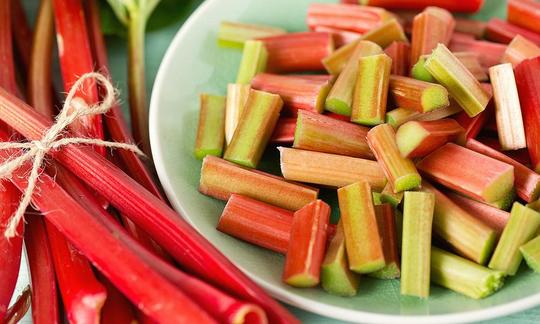

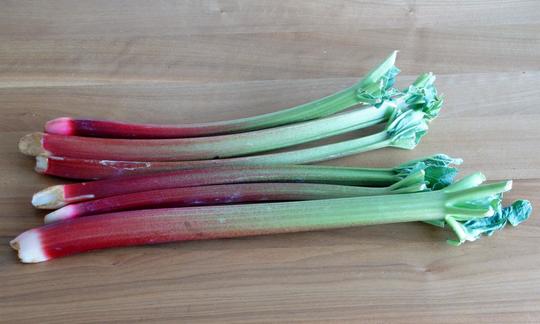

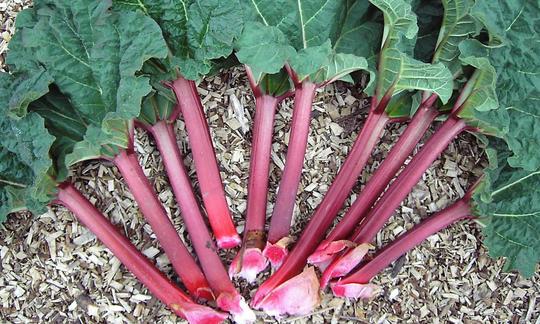

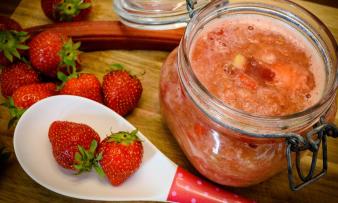
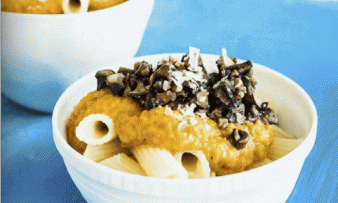





Comments